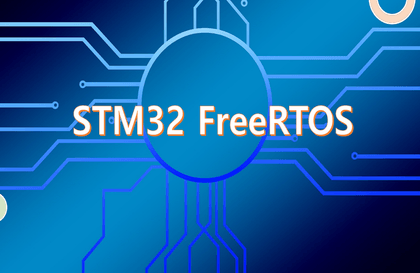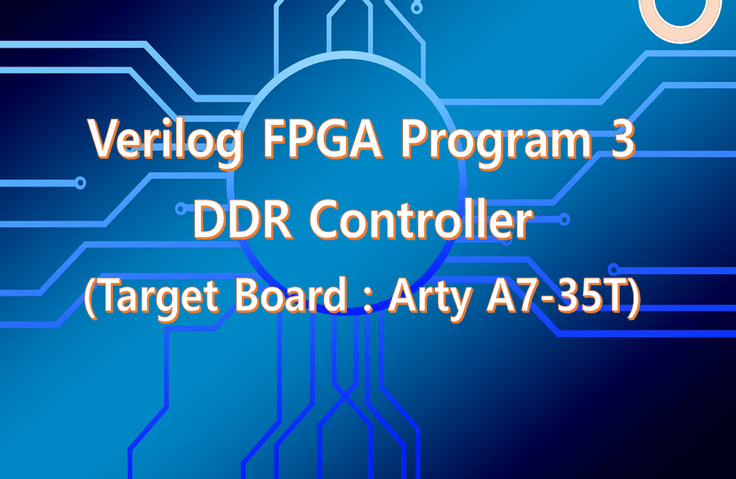
STM32 FreeRTOS 구현
alex
STM32 MCU에서 FreeRTOS를 구현하는 방법을 상세히 설명해 드립니다.
초급
FreeRTOS
Through this lecture, you will be able to implement a DDR controller using FPGA.

DDR Controller
Frame Buffer
What a skilled Verilog developer needs
DDR Memory Controller Skill! ✨
FPGAs provide many functions in the form of IP. Among them, we will explain the DDR Controller, which is mainly used to process image data.
1. Implement as per the data sheet
2. Implementation with IP provided by Xilinx
The author experienced many of these difficulties while implementing DDR Controller. I thought it would be good to have a single document that only organizes the necessary parts. It is efficient to first understand only the necessary parts, proceed with development, read/write DDR, and gradually increase your understanding. It is effective to first understand the overall structure, and then understand the details later. This book is organized so that even developers who are new to DDR Controller can easily approach it .
DDR Memory is very important in image data processing. However, it is difficult for non-experts to approach, and there are few materials covering this specialized subject. This lecture covers all the contents of implementing DDR Memory Controller . It also explains in detail how to implement Frame Buffer using DDR Controller.
💾 Please check before taking the class!
There are few documents that cover DDR Memory Controller. This lecture explains all the processes in detail. It explains all the processes from creating and simulating Memory IP to implementing DDR Memory Controller for general use and implementing Frame Buffer for image data processing. In addition, each source code is configured so that you can verify it through simulation and understand its operation.
If you understand all the contents of this lecture, you will become a capable developer who can not only implement DDR Controller but also implement FPGA using Verilog.
For those who want to learn Verilog, DDR Memory Controller is a very good skill. There are many people who have a lot of development experience but have not encountered DDR Memory Controller. We provide an opportunity to upgrade Verilog to the next level.
For those who purchase this course, we will provide all the sources explained in the course. The sources provided are composed of materials that have been coded and verified from the beginning while producing the course. In addition, they are composed of codes that can be used immediately in the field. We hope that you will become a master of DDR Controller through this course.
This lecture explains the process of creating DDR Controller IP and how the created IP operates through simulation to understand the operating process , and design a DDR Controller that can be used universally using the created IP . Finally, it explains the process of implementing a Frame Buffer for processing image data .
This lecture is based on the author's experience in developing ISP (Image Signal Processing) for a long time . The contents of this book are codes that can be applied directly to practical work . The contents may include some difficult parts , but please read the parts you do not understand 2-3 times and review the operation contents while simulating the codes.
This lecture will be conducted on the Arty A7 development board sold by Digilent. When dealing with FPGA, it is very important to apply it to HW and check the results. There are limits to implementing it through simulation. It must be verified on HW. (It is regrettable that the content on the frame buffer covered in the last chapter of this book was verified only through simulation because we could not find a suitable HW. We hope to find a suitable board in the future and proceed with HW verification.)
Chapter 1 is an overview of the overall content.
Chapter 2 describes the Arty A7 board used for the exercises .
Chapter 3 explains how to create DDR Controller IP and User Interface Logic .
Chapter 4 understands the operational characteristics of the generated DDR Controller IP through simulation . This is very important for implementing a DDR Controller that can be used for general purposes .
Chapter 5 implements a general-purpose DDR Controller and implements Read/Write across the entire DDR Memory area . It also generates a Bitstream and checks the results on the board .
Chapter 6 looks at Memory Access speed and covers how to achieve maximum speed .
Chapter 7 implements a Frame Buffer for video data processing using the general-purpose DDR Controller implemented in Chapter 5 .
Chapter 8 implements a 32-bit interface using two 16-bit DDR memories.
Chapter 9 implements the DDR Controller in Spartan6.
Chapter 10 implements the DDR4 Controller.
See previous lectures together 👀
Q. Is it possible for Verilog beginners?
You should have basic knowledge of Verilog. Without it, it can be difficult.
Q. Is there anything to prepare?
We use the Arty A7 board to implement and verify the code. Once the board is ready, you can check the implementation yourself. However, since all sources are configured to be simulated, you can listen to the lecture first and verify it later when the board is ready.
Q. What program tools do you use?
I'm using vivado 2018.3 from Xilinx. Any version later than 2018.3 should work.
I have been working as a developer for over 20 years in large and small companies and currently run a small business. I have developed an ISP (Image Signal Processing) ASIC for CCTV and many products using FPGA such as OLED inspection equipment and DAQ (Data Acquisition System). In addition to FPGA, I have a lot of experience in FW development (STM32, PIC32, AVR, ATMEGA, etc.), circuit design, Windows Program, etc. I hope that my extensive experience will be helpful to your learning.
Who is this course right for?
Image data processing using FPGA
Frame Buffer Implementation
If you want to learn Verilog
If you want to learn FPGA
Need to know before starting?
Verilog
alive
FPGA
1,733
Learners
77
Reviews
128
Answers
4.8
Rating
19
Courses
저는 지난 20여년 동안 대기업, 중소기업에서 개발자로 일해왔고
현재는 작은 기업의 대표로 있습니다.
주요 경력사항은
Verilog HDL을 이용한 FPGA 설계
CCTV용 ISP ASIC 개발 (약 10년)
OLED Display 검사장비 개발 (약 3년)
FPGA를 이용한 장비 개발
MCU FW
STM32
PIC32
AVR, ATMEGA
DSP (TI)
Windows Application Program
Visual Studio MFC, C++
입니다.
All
277 lectures
Course Materials:
All
6 reviews
5.0
6 reviews
Reviews 2
∙
Average Rating 5.0
5
좋은 강의 내용으로 많은 도움이 될것 같습니다. 여러번 반복 해서 보고 있습니다. 감사합니다.
감사합니다. 강의 통해서 ddr controller를 완전히 이해하시길 바랍니다. xilinx 에서 제공하는 ip 하나를 정복하면 다른 ip들도 사용하는데 많은 도움이 됩니다~ fpga 분야가 쉽지 않은 분야입니다. 끝까지 완주 하시길 응원합니다 ~!!
Reviews 2
∙
Average Rating 5.0
Reviews 4
∙
Average Rating 5.0
Reviews 14
∙
Average Rating 5.0
5
MCU 할 때는 RAM에 대해 (요즘 자원이 풍부해서)큰 고민 없이 했었습니다. 그런데 FPGA나 Zynq를 하면서 HW공부하다 보니 RAM에 대한 고민을 하게 되면서 어려움을 많이 느꼈는데, 이 강의가 든든한 힘이 되었습니다. 계속 좋은 강의 자료 부탁드립니다~!
수강평 감사드립니다. MCU 환경과 FPGA 개발 환경은 많이 다른 것 같습니다. 어쩌면 딴세상일지 모르지요 ㅎ 강의 통해 도움되셨다니 감사합니다. 행복한 개발자, 능력있는 개발자 되시길 바랍니다. 감사합니다 ~!!
$84.70
Check out other courses by the instructor!
Explore other courses in the same field!